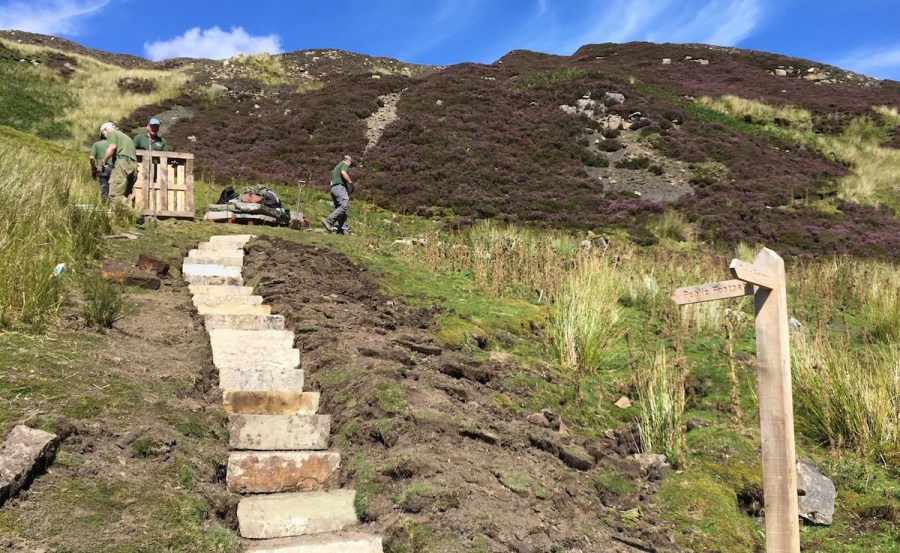A 220m-long flagged path has been laid across a badly eroded section of the C2C trail
It’s one of the biggest rights of way improvement projects ever undertaken by the Yorkshire Dales National Park Authority volunteers.
The Coast to Coast trail is popular, and becoming more so all the time thanks to recent media coverage such as Tony Robinson’s 2017 Coast to Coast programme. Currently, it’s estimated that around 7,000 people walk the trail every year, and the sheer volume of traffic is putting pressure on sections of the footpath. One section that has fared poorly is an area east of Keld in Swaledale known as Swinner Gill, which had become braided and boggy.
Due to the gill’s steepness and designation as a Site of Special Scientific Interest, access to the path was difficult and work needed to be strictly time-limited.
“Contractors were an option, but an expensive one,” said Area Ranger Michael Briggs. “Step forward our Dales Volunteers, including a group known as the Ragged Robins. We couldn’t have done it without them.”
After a day and a half of airlifting flags by helicopter, rangers and volunteers laid 432 flags, built three large stone flag bridges, created two flights of steps with 19 steps in each, and constructed 12 cross channels. Work started on 9 August and finished on 7 September. During this time 16 volunteers worked a total of 68 person days.
Alan Hulme, Head of Park Management, said: “The C2C provides one of the greatest walking experiences in the world for a significant number of overseas visitors to this country as well as UK residents. By improving this route, this project has had a positive impact on people’s ability to enjoy the special qualities of this national park.”
Flagged paths can be seen on many high routes throughout the UK. Although labour intensive to lay, they create a hard-wearing, long-lasting surface that allows areas of erosion to recover and vegetation to grow back. Not every walker likes them, though; some have found miles on flagstone paths can result in blisters, and unless the stone is carefully sourced they can have a big visual impact.
When asked about the stones used for the path, Michael Briggs said: “We try to source reclaimed flagstones and on this occasion they were supplied by Metcalfe Reclamation Ltd from Heywood in Greater Manchester. We use sandstone flags as they won’t polish over time and become slippery – like limestone would.
“We’re told that many of the flags came from demolished railway stations and siding. Others came from the floors of old mills across South Yorkshire or Lancashire. They still have the marks or holes where machines were fastened down.”
He added: “I’d also like to give special thanks to Access Ranger Ian Broadwith, who expertly led the team during this work. It was Ian’s last big project with the volunteers, as he is due to retire in November.”
The purchase of the flagstones and the airlifting to site was fully funded by the YDNPA’s Public Rights of Way budget.
Volunteers complete major work on Coast to Coast path








